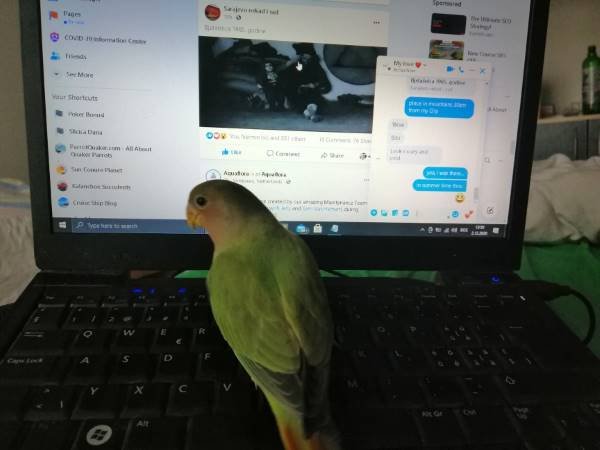The famous term “Love Birds” that is commonly used around the world for explaining the intensity of love between two people is accredited to the parrot species of the same name, Love Birds. While entering the colorful world of parrots, almost all of the new parrot admirers are advised to adopt ‘Love Birds’ as their first set of parrots.
Inhabiting majorly the African parrots, LoveBirds is a group of nine subspecies with only one of them native to Madagascar; the other eight belong to the African continent. Where the first 3 of these species are widely adopted as pets across the globe, the rest are rare with some deemed unsuitable to survive in captivity.
Rosy-Faced LoveBird
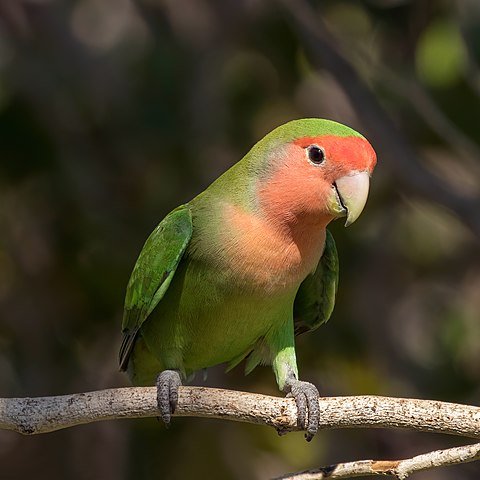
Famed as Peach-faced Lovebird, this subspecies of the lovebird is one of the commonest lovebirds types to be kept as pets. They are easy to care for and breed but might get a little aggressive at times.
Habitat- Native to the dry regions of southwest Africa, they inhabit open countrysides of southwest Angola and to Namibia until the Orange River in southwestern African regions. They are mostly found around the water sources and dwell in the mountains, woodlands, and semi-desert regions.
Size- Around 17-18 cm from head to tail, Peach-faced Lovebirds are quite a small species. They have a wingspan of 106mm and weigh around 55 grams.
Appearance- They have a distinct pink face and throat and the shade tends to be darker above the eyes and on the forehead. The plumage is dark green with a blue rump. The feet and legs are gray. They have a brown iris and a horn-colored bill.
Read about their Breeding Behaviour Here.
Also, How to stop Biting behaviour in Lovebirds.
Subspecies- Known as Agapornis Roseicollis scientifically, this subspecies has further two subspecies:
- Agapornis Roseicollis Catumbella
- Agapornis Roseicollis Roseicollis
Yellow-collared LoveBird
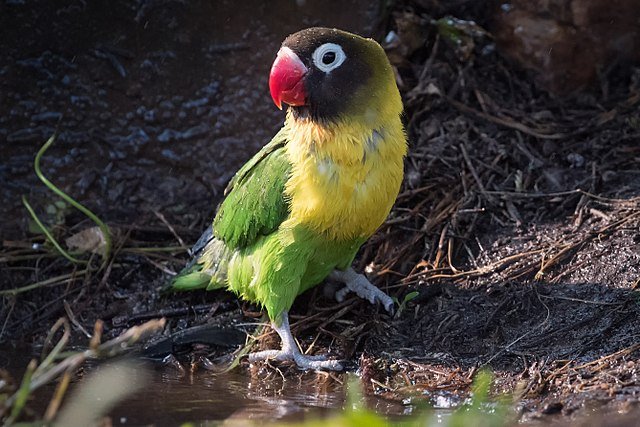
Famed as Black-masked Lovebird, this is another famous pet Lovebird species. They are a bit less aggressive than the Peach-faced Lovebirds.
Habitat- Native to the northeastern region of Tanzania, the subspecies was later introduced to Kenya and Burundi.
Size- These birds average around 14.5 cm in size with males being a little larger and females, slightly smaller than the average. Their weight may range between 43 to 50 grams
Appearance- They have a black head and mask with bright red beak and white eye-rings standing out. The collar area and the breast are yellow that extends to the nape. The underparts are dark green
Subspecies- Scientifically called as Agapornis Personatus, the species have reportedly no subspecies but a variety of equally popular color mutations. The Cobalt, Blue, Lutino, Mauve, Violet, Slate, Olive, and Albino are just a few of such mutations.
Fischer’s LoveBird

Another popular pet lovebird species, Fischer’s lovebird is quite a star parrot.
Habitat- They are native to a smaller region of central-east Africa along with the south belt of Lake Victoria in northern Tanzania. However, with the changing climatic conditions, the species migrated to Burundi and Rwanda in search of water.
Size- Being just 14 cm from head to tail, they are a few of the smaller lovebird species. They can weigh around 43 to 58 grams.
Appearance- Majorly covered with a green plumage on the chest, back, and wings, their yellowish golden neck stands out. The color turns to a dark orange shade as it moves upwards towards the face. The beak is darkest orange and the head is olive green. The white eye-ring is striking apart from the purplish-blue tail feathers.
Subspecies- With no reported subspecies, a few of the many color mutations of Fischer’s include Blue, Lution, Pied, Albino, Black, White, and Cinnamon.
Lilian’s LoveBird
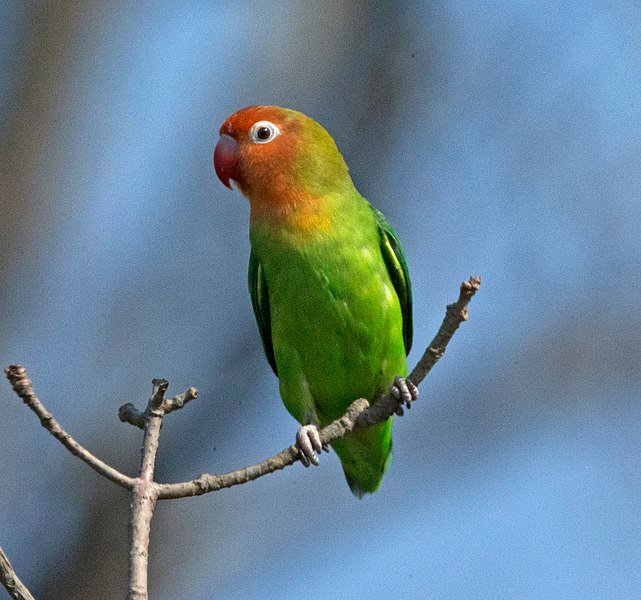
Nyasa Lovebird is the other name of this species and they are difficult to breed, hence, quite uncommon to be found.
Habitat- This parrot species can be found in his native region that covers areas of Mozambique, Malawi, Tanzania, Zimbabwe, and Zambia.
Size- Around 13.5 cm in length, their weight ranges between 28 to 37 grams.
Appearance- A brighter shade of orange on the head, neck, and upper breast, Nyasa has green plumage and white eye-rings for identification.
Subspecies- Known as Agapornis Lilianae scientifically, this species has no further subspecies but a few color mutations have been attempted like Lilian Wallington or Black-cheeked Nyasa. But they are rare to find as well as attempt. Many breeders struggle to breed even the nominate Lilian species.
Abyssinian LoveBird

Another rare species to find, breed, and pet, Abyssinian Lovebird has just started to gain a little popularity in recent years. They are also known as Black-winged Lovebird.
Habitat- The species is native to mountainous regions of southwestern Ethiopia and south Eritrea.
Size- Measuring around 16.5 cm from head to toe, this species happens to be the largest of the lovebird genus. They weigh around 58 grams.
Appearance- This is one of the subspecies of the lovebird that are dimorphic, i.e. the male and female aren’t identical. Where the male bird sports a red forehead, the female has it all green. The rest of the plumage is green in both sexes.
Subspecies- Called as Agapornis Taranta scientifically, it is believed that the species has one subspecies Agapornis Taranta Nana dwelling in the south of Ethiopia. But these claims aren’t verified by many yet.
Black-cheeked LoveBird
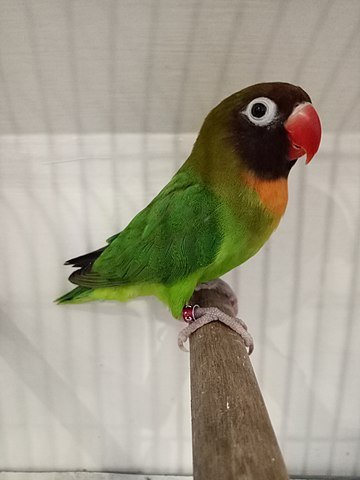
Initially recognized as a subspecies of Lilian’s Lovebird, the Black-cheeked is now recognized as an individual species.
Habitat- Native to the southwestern region of Zambia, they are even spotted in Botswana, Namibia, Zimbabwe. For the constant need for water to survive, they dwell in the deciduous woodlands with water sources around them.
Size- They are around 14 cm in length and weigh around 40 grams.
Appearance-They mainly has a green plumage with a brown forehead; a black face; brownish-black cheeks and throat; and white eye-rings.
Subspecies- Agapornis Nigrigenis scientifically, they have no subspecies nor color mutations. They are still difficult to breed and uncommon as pets just like in the past.
Black-collared LoveBird
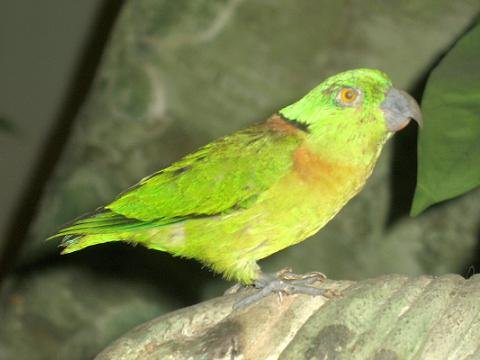
Swindern’s Lovebird aka the Black-collared Lovebird is rarely kept in captivity due to their survival dependency on the native figs.
Habitat- They can be found across the large range of equatorial regions of African forests of the Central African Republic, the Republic of Congo, Cameroon, the Democratic Republic of Congo, Côte d’Ivoire, Equatorial Guinea, Ghana, Gabon, Uganda, and Liberia.
Size- They have a length of around 13.5 cm and weigh anywhere between 39 to 41 grams.
Appearance- They are monomorphic and males, hence males and females are identical with an overall green plumage, a distinctive half-collar black band at the nape, olive-yellow chest, blue-red markings on the rump.
Subspecies- This shy lovebird species; Agapornis Swindernianus has three further known subspecies namely:
Agapornis Swindernianus Zenkeri
Agapornis Swindernianus Swindernianus
Agapornis Swindernianus Emini
Madagascar LoveBird
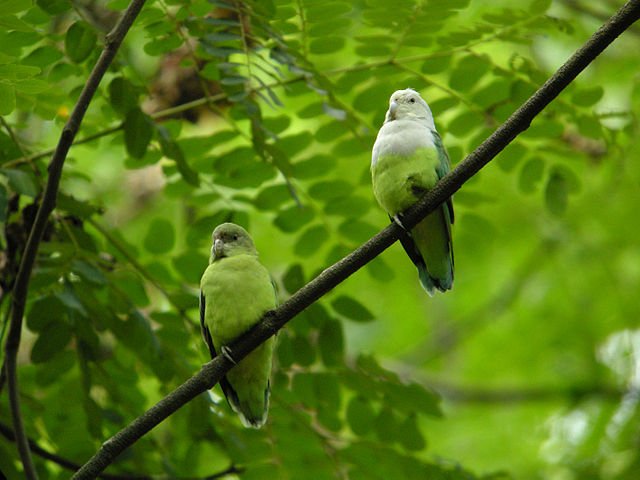
Commonly famed as Grey-headed Lovebirds, this is another dimorphic species of lovebird genus.
Habitat- They are the only lovebirds that aren’t native to Africa. They happen to inhabit the Madagascar island off the African coast.
Size- Madagascar is the smallest of the lovebird genus and measures just 13 cm and weighs a meager 30 to 36 grams.
Appearance- The female parrot has an overall green plumage with a darker shade on the wings and back; and paler on the chest. But male parrots are entirely pale gray on their head and upper chest, it almost looks like an off-white shaded plumage.
Subspecies- Scientifically called as Agapornis Canus, the grey-headed have been known to have two subspecies:
Agapornis Canus Ablectaneus
Agapornis Canus Canus
Red-faced LoveBird
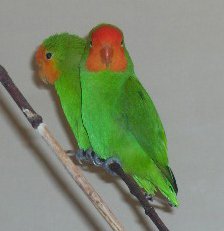
Also called the Red-headed Lovebird, breeding them in captivity has been met with failure. The species can not survive long without the native conditions viz-a-viz nesting and companionship needs.
Habitat- The species seem to have the largest native expanse and can be found in the tropical rainforests of equatorial Africa, Sierra Leone, Uganda, northern Angola, and Liberia.
Size- The species stands at 15 cm long and has an average weight of 43 grams.
Appearance- Sporting an overall green plumage, they have a red forehead, face, and beak. The read extends to the slides of the cheeks to the eyes. The feet and legs are gray and eyes are brown. Females can be told apart with the orange face and cheeks and paler beak.
Subspecies- Scientifically; Agapornis Pullarius, the species is reported to have further two subspecies:
Agapornis Pullarius Pullarius
Agapornis Pullarius Ugandae
Summing Up
A genus seemingly offering many alternatives to choose a pet from, the practicality of all of the subspecies of lovebirds have a different reality. With only three subspecies fit to be captivated, attempts at trying to pet others have met with an unfortunate end. So, it is always better to know a little about the subspecies of lovebird before adopting, just for the good of the little being.



